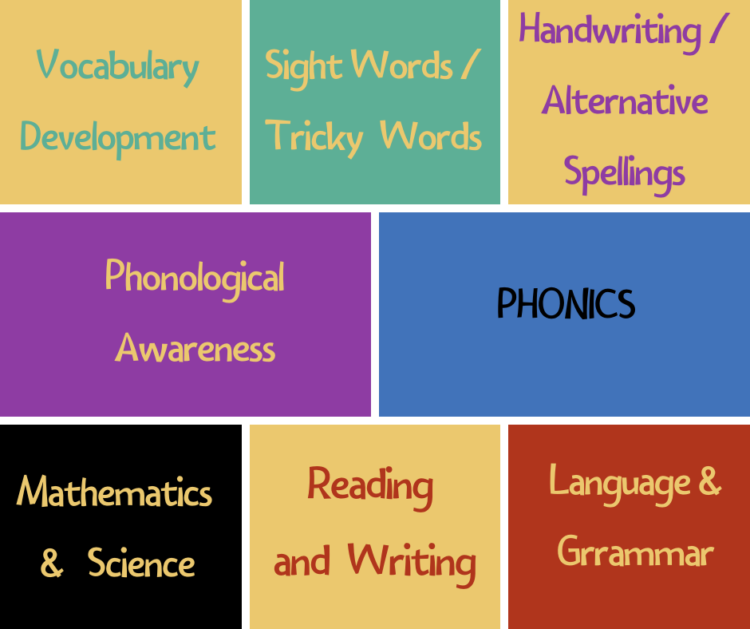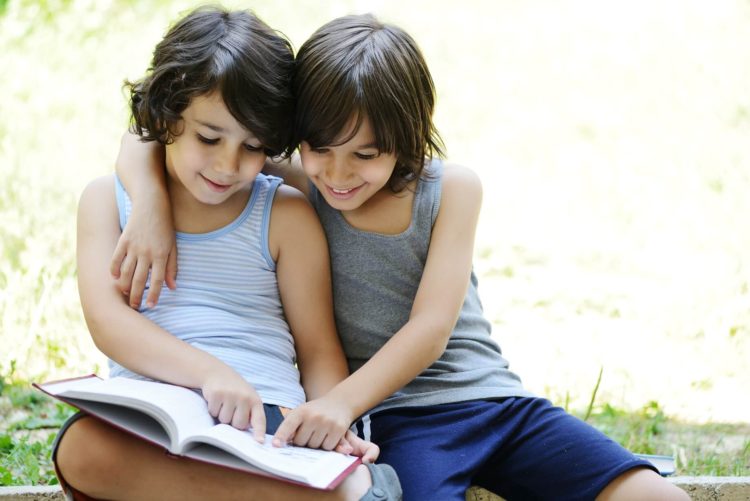

How to Foster Early Literacy for Parents and Teachers
Check out this early literacy overview to learn more about the skills that give students the foundation they need to learn and grow. These skills include vocabulary, phonological awareness, phonics, sight words, language, and numeracy.
An Early Literacy Curriculum includes skills students need to transition from learning to read to reading to learn.

Research shows these early literacy skills are best developed through talking, singing, reading, writing, and playing. From the time you arrive home with your newborn, what you do every day helps prepare your child to become a successful reader.
Early Literacy Overview: The Importance of Play
- “Play is often talked about as if it were a relief from serious learning. But for children, play is serious learning. Play is really the work of childhood,” Fred Rogers, aka Mr. Rogers. You might want to check out: Why Play Is The Work of Childhood – Mr. Rogers Center.
- Through play, children develop language skills. They learn to…
- communicate ideas.
- interact with peers.
- negotiate.
- solve problems.
- create stories.
- develop characters.
- write lists.
- listen to friends.
- name animal.
- create rhymes.
- play with letters and sounds.
- read stories.
- write stories.
- explore life events.
- There is no denying children need to play. They need to process learning and life events. There needs to be unstructured play for the imagination to run wild.
- There also needs to be structured play and opportunities to play with knowledge. that has been taught.
- Children come from varied backgrounds and experiences.
- Teachers must provide numerous and varied learning opportunities to maximize each child’s learning potential.
- Teach. Play. Learn.
Early Literacy Overview: Phonological Awareness
- Phonological Awareness includes identifying and manipulating units of oral language.
- Phonological Awareness includes onset and rime, rhyming syllables, compound words, and phonemic awareness.
- As kids learn to manipulate oral language, they begin to practice the concepts independently. (i.e., After kids recognize rhyming words, they begin to create their own rhymes.)
- Early phonological awareness happens with words and syllables. Once kids have a strong awareness of how spoken language works, they can begin to work with the smaller units of sound. This part of phonological awareness is often referred to as phonemic awareness.
Early Literacy Overview: Phonemic Awareness
- Phonemic Awareness is the part of phonological awareness where children focus on and manipulate individual sounds (phonemes) in spoken words. (i.e., The children play games to blend or segment sounds in words orally.)
- An Early Literacy Curriculum includes Phonological Awareness because it provides a starting point for reading readiness. Visual Discrimination and Auditory Processing form the foundation for learning to read.

Early Literacy Overview: Phonics
- First of all, children learn to read and write, beginning with the Sounds of the Letters.
- JOLLY PHONICS is an excellent program for learning the letter sounds; because it connects the letter sounds to the letter(s) representing them.
- Children see a group of letters (i.e., cat), connect the sound to the print, and Blend the sounds for Reading.
- They learn to Segment the Sounds they hear in a word for Writing. (i.e. sheep = /sh/-/ee/-/p/)
- They learn simple to complex words in decodable text.
- Jolly Learning has Sample Lessons that explore teaching using systematic/synthetic phonics.

Early Literacy Overview: Vocabulary
- A child’s vocabulary develops from things like you talking with your child (i.e., “I like how you smile.”), explaining things that happen in their environment (i.e., “That was the doorbell.”), listening to stories, conversations, talking about things in nature (i.e., “That big, green tree has pine cone on it.”), and problem-solving.
- Games like “I have, Who has?” or “Name this Animal.” may introduce new words to your child.
- An increased vocabulary provides prior knowledge for children when they are learning to read and write.

Early Literacy Overview: Sight Words / Tricky Words
- Next, the children learn to read and write sight words. (e.g., I, me, the, like, here, go)
- These tricky words do not follow the rules! It is best to look to sounds you know and talk about how tricky the unknown letter or letter combinations are in making sounds. These words are often taught with a “look and say” approach.
- It is beneficial if parents help their children practice sight words at home.
- Sight words provide words needed to connect decodable text. (i.e., the dog)
- The children read and write words (i.e., fish); phrases (i.e., a big fish); simple sentences (i.e., I saw a big, blue fish.); and then paragraphs. (e.g., We went to the aquarium yesterday. I saw a big, blue fish. There were lots of sea animals at the aquarium.)
Early Literacy Overview: Printing Practice and Alternative Spellings
- Handwriting is an important skill.
- Parents can help their children learn the correct pencil grip.
- They learn to make letters that flow and therefore, avoid letters created with sticks and stones!
- Once the children learn a sound, they connect the letter(s) to the sound and record it.
- Children learn how to print words, phrases, and then sentences… so that others can read their writing.
- See it. Say it. Print it.
Early Literacy Overview: Language and Grammar
- Learning Grammar follows learning to read and write.
Without question, Learning to Read and Write is Complicated!
Early Literacy Overview: Mathematics and Science
- Math and Science activities include learning about colors and shapes, matching games, creating patterns, and sequencing.
- An Early Literacy Curriculum includes mathematics and science because many of these skills transfer to reading readiness.









